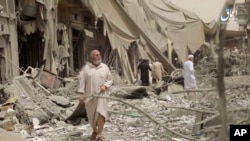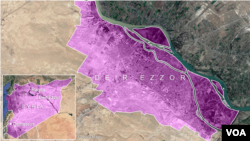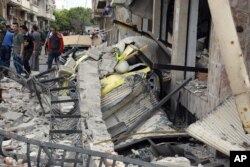Syria's conflict is tilting to the east of the war-wracked country, where Syrian army forces and Shi’ite allies this week launched several offensives in the desert bordering Iraq and the U.S.-led coalition conducted a series of airstrikes. One strike Wednesday killed a senior Islamic State propagandist. U.S.-backed Sunni rebels also have been mounting raids along the Syria-Iraq border.
Syrian government officials claim to have inflicted heavy losses on IS since Wednesday with attacks by the regime’s Republican Guard to the west of Deir al-Zor and by the Syrian Arab Army’s 104th and 123rd brigades in prolonged skirmishes in the city’s al-Rishdieh and al-Hawiqah districts.
The attacks mark a surge in the regime’s weeks-long military offensive in eastern Syria, which has coincided with repeated hints by the leaders of Iranian-backed Iraqi Shi’ite militias that they may decide to cross the border, move into Syria and link up with the forces of President Bashar al-Assad. The militias have been redoubling their efforts to clear IS fighters from villages on the Iraqi side of the border.
The military movements not only are squeezing Islamic State and hindering the jihadists from going back and forth across the border, which in the past they have used to great tactical advantage, according to analysts. They also appear to be tied to a jockeying for position among rival local forces backed by different powers, raising the specter of Syria's partition, dividing the country into zones of influence.
Aron Lund, an analyst at The Century Foundation, a U.S.-based research institution, says the moves are not just about driving out IS from eastern Syria, but preventing rivals from filling the void.
“The presence of foreign embeds and air cover for many of the forces now fighting in Syria – Russian and Iranian troops on Assad's side, Americans with the Kurds, Turkish special forces among some rebels, Jordanian and American or even Norwegian advisers among other rebels – is another driver of the eastward motion,” Lund said.
“As the Islamic State contracts, Assad and some of his rivals are hurrying to grab as much as they can of the Euphrates and border areas, while they are still in play,” he added in an email to VOA.
Some U.S. analysts argue that the push eastward by Assad’s forces — which escalated after May 4 Russian-brokered "peace talks" in the Kazakh capital of Astana that saw Moscow, Tehran and Ankara sign off on a cease-fire for four western and southern Syria territories — is part of a Damascus-Tehran plan to block the United States and any proxy forces from expanding into eastern Syria.
“These movements suggest that pro-regime forces intend to insert themselves into the campaigns against IS in Raqqa city and Deir al-Zor province - thereby preempting long-term expansion by the U.S. in eastern Syria,” said Chris Kozak of the Institute for the Study of War, a Washington-based research institution.
The institute has warned that a linking of Assad’s forces with Iraq’s Iranian-backed militias would strengthen Tehran’s hand in both Syria and Iraq across the Levant, undermining the Trump administration’s stated aim of opposing the expansion of Iranian influence in the region. It has advocated that the U.S. refocus its campaign against IS in Syria toward Deir al-Zor province as “a long-term base for operations against both IS and the Russo-Iranian Coalition in Syria.”
Airstrikes, launched by both the U.S.-led coalition and the Syrian regime, as well as Iraqi government warplanes, continued to pummel parts of eastern Syria into Thursday, reported the Syrian Observatory for Human Rights, a Britain-based watchdog that relies on a network of activists inside Syria for its information. The observatory had no details on casualties, but last week, the U.N.’s human rights chief warned of a “rising toll of civilian deaths” in both Deir al-Zor and Raqqa, the one-time de facto capital of IS.
Zeid Ra’ad al-Hussein, United Nations High Commissioner for Human Rights, called in a statement for all air forces operating in Syria to take greater care to distinguish between legitimate military targets and civilians. His statement came after reports of at least 35 civilian deaths in an airstrike on al-Mayadin, a town held by the jihadists near Deir al-Zor.
Some of the civilians were thought to be family members of foreign IS fighters. Many of the group’s fighters have been massing in Syria’s Euphrates basin area after fleeing from other fronts in both Syria and Iraq. Spokesmen for the U.S.-led coalition say they try to be careful to avoid civilian casualties in airstrikes, but are faced with challenges because jihadists are mixed in with civilians and use them as human shields.
On Sunday, U.S. Defense Secretary Jim Mattis said in an interview with CBS the Pentagon was doing “everything humanly possible” to avoid noncombatant casualties as it pursued “annihilation tactics against IS.” Some NGO’s say the civilian death toll is likely to climb amid President Donald Trump’s accelerated pace of combat.
The U.S.-led coalition has officially acknowledged responsibility for more than 450 civilian deaths since its bombing campaign began in 2014, including 105 in Mosul, Iraq in March.








